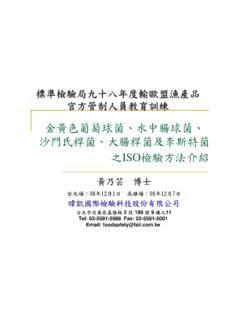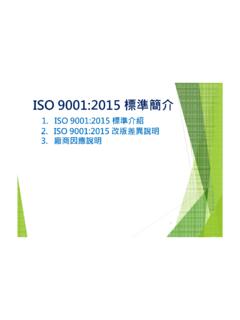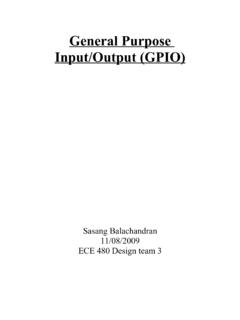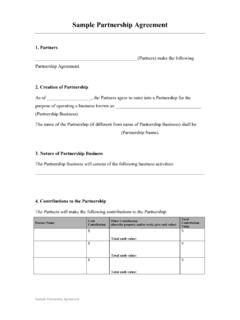Transcription of GENERAL STANDARD FOR FOOD ADDITIVES
1 CODEX STAN 192 Page 1 GENERAL STANDARD FOR food ADDITIVESCODEX STAN 192-1995, Rev. 3-20011. PERMITTED food ADDITIVESOnly the food ADDITIVES listed herein are permitted for use in foods in conformance with theprovisions of this Standard1. Only food ADDITIVES which have been evaluated by the Joint FAO/WHO ExpertCommittee on food ADDITIVES (JECFA) and found acceptable for use in foods are included in this FOODS IN WHICH ADDITIVES MAY BE USEDThis STANDARD sets forth the conditions under which permitted food ADDITIVES may be used in all foods,whether or not they have previously been standardized by Codex. The food additive provisions of CodexCommodity standards shall be included in and superseded by the provisions of this STANDARD . Theseprovisions also comply with the other requirements of the FOODS IN WHICH ADDITIVES MAY NOT BE USEDFood categories or individual food items where the use of food ADDITIVES are not allowed or arerestricted are defined by this THE PERMITTED LEVELS OF USE FOR food ADDITIVESThe primary objective of establishing permitted levels of use of food ADDITIVES in various food groupsis to ensure that the intake of ADDITIVES does not exceed the acceptable daily food ADDITIVES covered by this STANDARD and their maximum levels of use are based in part on thefood additive provisions of previously established Codex commodity standards .
2 Or upon the request ofgovernments after subjecting the requested maximum levels to an appropriate method which would verify thecompatibility of a proposed maximum level with the Danish budget method may be used as a first step in this regard2. The submission of actual foodconsumption data is also DEFINITIONS OF TERMS USED IN THIS STANDARDa) food additive means any substance not normally consumed as a food by itself and not normally used asa typical ingredient of the food , whether or not it has nutritive value, the intentional addition of which tofood for a technological (including organoleptic) purpose in the manufacture, processing, preparation,treatment, packing, packaging, transport or holding of such food results, or may be reasonably expectedto result (directly or indirectly), in it or its by-products becoming a component of or otherwise affectingthe characteristics of such foods.
3 The term does not include contaminants or substances added to foodfor maintaining or improving nutritional 1 Notwithstanding the provisions of this Section of the GENERAL STANDARD , the lack of reference to a particular additive or to aparticular use of an additive in a food in the GENERAL STANDARD as currently drafted, does not imply that the additive isunsafe or unsuitable for use in food . The Commission shall review the necessity for maintaining this footnote on a regularbasis, with a view to its deletion once the GENERAL STANDARD is substantially Consensus Document on the Danish Budget Method , Nordic Working Group on food Toxicology and Risks Evaluation,Report No. 4 Alimentarius, Second Edition (Revised 1995), Volume 1A ( GENERAL Requirements), p.
4 STAN 192 Page 2b) Acceptable Daily Intake (ADI) is an estimate by JECFA of the amount of a food additive, expressedon a body weight basis, that can be ingested daily over a lifetime without appreciable health risk( STANDARD man = 60 kg).4c) Acceptable Daily Intake "Not Specified" (NS)5 is a term applicable to a food substance of very lowtoxicity which, on the basis of the available data (chemical, biochemical, toxicological, and other), the totaldietary intake of the substance arising from its use at the levels necessary to achieve the desired effectand from its acceptable background in food does not, in the opinion of JECFA, represent a hazard tohealth. For that reason, and for reasons stated in individual JECFA evaluations, establishment of anacceptable daily intake expressed in numerical form is not deemed necessary by JECFA.
5 An additivemeeting this criterion must be used within the bounds of good manufacturing practice as defined in sub-paragraph GENERAL PRINCIPLES FOR THE USE OF food ADDITIVES a) Only those food ADDITIVES shall be endorsed and included in this STANDARD which, so far as can bejudged on the evidence presently available from JECFA, present no risk to the health of theconsumer at the levels of use ) The inclusion of a food additive in this STANDARD shall have taken into account any AcceptableDaily Intake, or equivalent assessment, established for the additive and its probable daily intake7from all sources. Where the food additive is to be used in foods eaten by special groups ofconsumers, account shall be taken of the probable daily intake of the food additive by consumersin those The use of food ADDITIVES is justified only when such use has an advantage, does not present a hazardto health of and does not mislead the consumer, and serves one or more of the technological functions set outby Codex and needs set out from (a) through (d) below, and only where these objectives cannot be achievedby other means which are economically and technologically practicable:a) to preserve the nutritional quality of the food .
6 An intentional reduction in the nutritional quality ofa food would be justified in the circumstances dealt with in sub-paragraph (b) and also in othercircumstances where the food does not constitute a significant item in a normal diet; 4 Principles for the Safety Assessment of food ADDITIVES and Contaminants in food , World Health Organization, (WHOE nvironmental Health Criteria, No. 70), P. 111 (1987).5 For purposes of this STANDARD , the phrase acceptable daily intake (ADI) not limited (NL) has the same meaning as ADI not specified . The phrase acceptable ADI refers to an ADI which is more appropriately limited by the level oftreatment of the food , rather than on a mg additive per kg body weight per day basis (see, Summary of EvaluationsPerformed by the Joint FAO/WHO Expert Committee on food ADDITIVES (JECFA), FAO/WHO, ILSI Press, 1994, Part 1, ).
7 6 GENERAL Principles for the Use of food ADDITIVES were originally adopted by the Ninth Session of the Codex Alimentariusas a Codex Advisory Text (para. 295, ALINORM 72/35) and were reprinted in the Second Edition of the CodexAlimentarius, Vol. 1A, ( GENERAL Requirements) pp. 45-47 (Revised 1995). Pertinent portions of the Text have now beenincorporated as an integral part of this STANDARD , suitable modifications having been made as necessary with respect to thepresent "Guidelines for Simple Evaluation of food Additive Intake", CAC/VOL. XIV Ed. 1, Supplement 2 (1989), givesprocedures for calculating the theoretical maximum daily intake (TMDI) and the estimated daily intake (EDI) of foodadditives; other appropriate procedures may be used to calculate the TMDI and STAN 192 Page 3b) to provide necessary ingredients or constituents for foods manufactured for groups ofconsumers having special dietary needs;c) to enhance the keeping quality or stability of a food or to improve its organoleptic properties,provided that this does not change the nature, substance or quality of the food so as to deceivethe consumer.
8 D) to provide aids in the manufacture, processing, preparation, treatment, packing, transport orstorage of food , provided that the additive is not used to disguise the effects of the use of faultyraw materials or of undesirable (including unhygienic) practices of techniques during the courseof any of these GOOD MANUFACTURING PRACTICE (GMP)8 All food ADDITIVES subject to the provisions of this STANDARD shall be used under conditions of goodmanufacturing practice, which include the following:a) the quantity of the additive added to food shall be limited to the lowest possible level necessaryto accomplish its desired effect;b) the quantity of the additive that becomes a component of food as a result of its use in themanufacturing, processing or packaging of a food and which is not intended to accomplish anyphysical, or other technical effect in the food itself, is reduced to the extent reasonably possible.
9 And,c) the additive is prepared and handled in the same way as a food SPECIFICATIONS FOR THE IDENTITY AND PURITY OF food ADDITIVESFood ADDITIVES used in accordance with this STANDARD should be of appropriate food grade quality andshould at all times conform with the applicable Specifications of Identity and Purity recommended by theCodex Alimentarius Commission9 or, in the absence of such specifications, with appropriate specificationsdeveloped by responsible national or international bodies. In terms of safety, food grade quality is achievedby compliance with the specifications as a whole and not merely with individual CARRY-OVER OF food ADDITIVES INTO COMPLIANCE WITH THE CARRY-OVER PRINCIPLEO ther than by direct addition, an additive may be present in a food as a result of carry-over from afood ingredient, subject to the following conditions:a) the additive is permitted in the raw materials or other ingredients (including food ADDITIVES )according to this GENERAL STANDARD ; 8 For additional information, see Codex Alimentarius Commission Procedural Manual, Tenth Edition (1997), p.
10 Additive specifications endorsed by the Codex Alimentarius Commission are included in the JECFA "Compendium ofFood Additive Specifications", Volumes 1 and 2 (1992), and in addenda thereto, published by principle relating to the carry-over of food ADDITIVES into foods (the "Carry-Over Principle") addresses the presence ofadditives in food as a result of the use of raw materials or other ingredients in which these ADDITIVES are used. The CodexAlimentarius Commission at its 17th Session (1987) adopted a revised statement of the principle as a Codex AdvisoryText. The Text is printed in its entirety in Codex Alimentarius, Second Edition, Vol. 1A ( GENERAL Requirements), pp. 94-95, 1992. The Carry-Over Principle applies to all foods covered by Codex standards , unless otherwise specified in STAN 192 Page 4b) the amount of the additive in the raw materials or other ingredients (including food ADDITIVES )does not exceed the maximum amount so )












